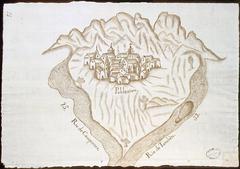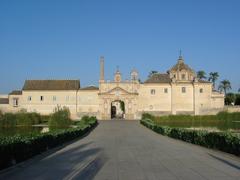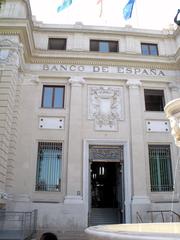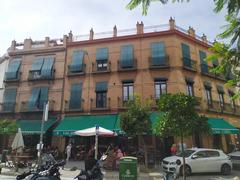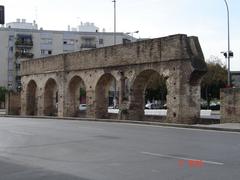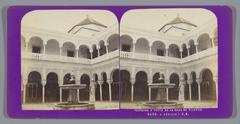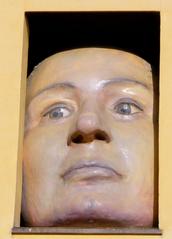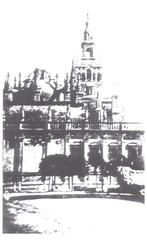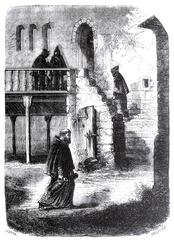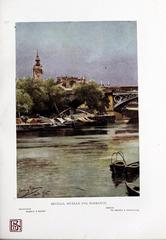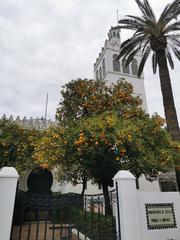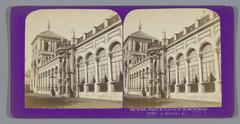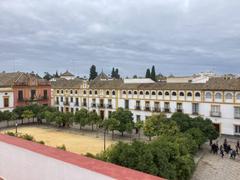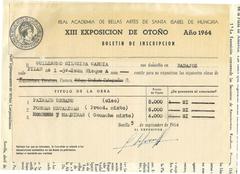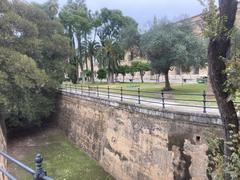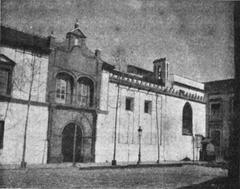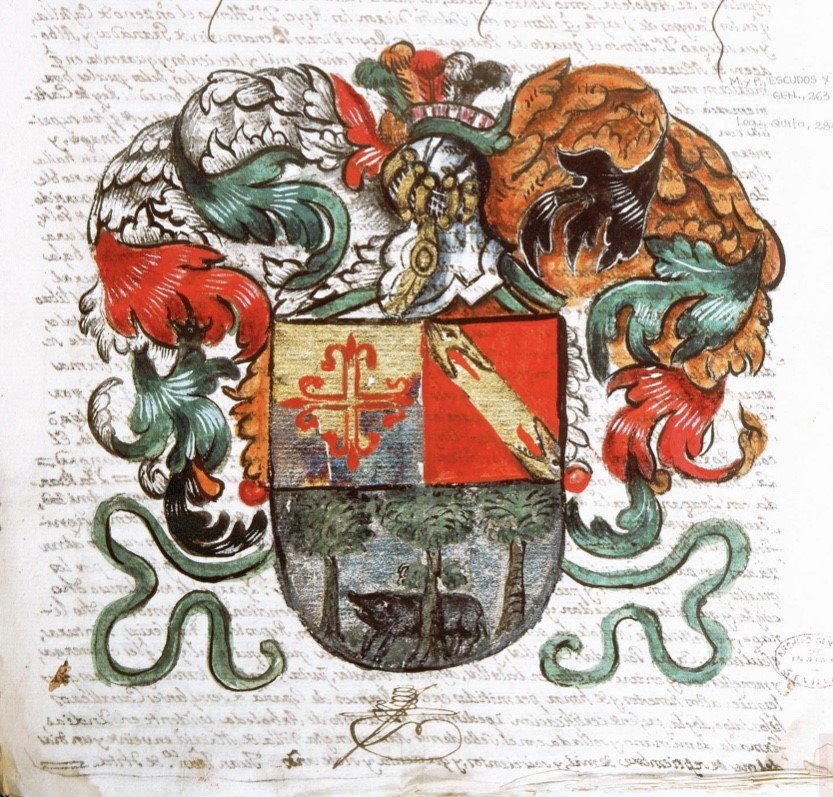
A Visitor’s Guide to the General Archive of the Indies in Seville: Hours, Tickets, and Historical Significance
Introduction
The General Archive of the Indies (Archivo General de Indias) in Seville is one of Spain’s most significant cultural landmarks and a UNESCO World Heritage Site. Housed in a grand Renaissance building, the archive preserves the documentary legacy of Spain’s vast colonial empire in the Americas and beyond. Whether you are a history enthusiast, researcher, or curious traveler, visiting the archive provides a window into centuries of global history, architecture, and cultural exchange. This guide compiles everything you need to know: visiting hours, ticketing, accessibility, highlights, and the historical significance of this extraordinary institution (visit-andalucia.com; España Guide; UNESCO).
Historical Overview
Origins and Architectural Foundations
The building that houses the General Archive of the Indies was originally constructed as the Casa Lonja de Mercaderes, or Merchants’ Exchange. Commissioned by King Philip II in 1572 and designed by Juan de Herrera, the architect of El Escorial, it was completed between 1584 and 1598. Its distinctive Renaissance style, with Italianate influences, is evident in its balanced proportions, harmonious arcades, and use of both stone and red brick. The building was intended to centralize the activities of the powerful Seville Merchant Guild, which played a pivotal role in Spain’s monopoly over American trade (España Guide; Wikipedia).
As Seville’s prominence as a trading port waned and activities shifted to Cádiz, the building’s function varied—serving as tenements, an art academy, and apartments—until its repurposing as the central archive for colonial records in 1785 by order of King Charles III (España Guide; Visit-Seville).
Establishment and Growth of the Archive
The late 18th century saw an urgent need to centralize Spain’s vast colonial documentation, previously scattered in multiple archives. King Charles III’s 1785 decree initiated the transformation of the Casa Lonja into the Archivo General de Indias. Documents—ranging from royal decrees and navigational charts to correspondence and legal records—were meticulously transferred to Seville. This centralization both streamlined colonial administration and preserved a unique historical record (labelleseville.com).
Today, the archive holds approximately 43,000 volumes and over 80 million pages of documents, including maps, plans, and rare manuscripts. Its holdings span from the earliest days of Spanish exploration through the 19th century, providing unparalleled insight into the workings of Spain’s global empire (visit-andalucia.com).
Architectural Highlights
Renaissance Features and Interior Spaces
The archive exemplifies Spanish Renaissance architecture, with its square layout surrounding a luminous central patio, two stories above a massive stone base, and a façade combining stone and red brick. Subtle decorative elements—pilasters, cornices, and balustrades—reflect Herrera’s preference for harmony over ornament. Inside, natural light floods the checkered stone patio, while portraits, artifacts, and the grand marble staircase (installed in 1787) evoke the building’s evolution and Spain’s global connections (España Guide; Wikipedia).
Adaptive Reuse
The building’s robust stone construction and spacious interiors made it ideal for archival use. During the transformation, partitions were removed to restore open-plan galleries. Enhancements, such as the marble staircase, were carefully integrated to complement the Renaissance style.
Visiting the Archive: Hours, Tickets, and Amenities
Opening Hours
- Tuesday to Saturday: 9:30 am – 5:00 pm
- Sunday and holidays: 10:00 am – 2:00 pm
- Closed: Mondays and certain public holidays
It is advisable to check the official website for any seasonal changes or special closures.
Admission and Ticketing
Admission is free for all visitors. No advance booking is required for general entry, but guided tours—highly recommended for deeper understanding—may require reservation, especially during peak seasons (Ministerio de Cultura y Deporte).
Guided Tours and Accessibility
- Tours: Free guided tours are offered primarily in Spanish, with some availability in English. Audio guides and brochures are provided in multiple languages.
- Accessibility: The archive is wheelchair accessible, with ramps, elevators, and accessible restrooms. An accessible entrance is available on the side facing the Alcázar (A Piece of Travel).
- Amenities: Restrooms, water fountains, and a gift shop are available. While there is no on-site café, numerous dining options are located nearby.
Visitor Conduct and Photography
- Photography: Permitted in public areas without flash or tripods. Restrictions may apply in special exhibitions.
- Conduct: Please maintain silence, refrain from eating or drinking, and respect archival rules to preserve the integrity of the collections.
Collection Highlights and Research Access
Scope and Content
The archive preserves approximately 43,000 bundles (legajos), or over 80 million pages of documents, covering the administration, exploration, commerce, and daily life of Spain’s overseas territories from the late 15th to 19th centuries (guides.uflib.ufl.edu). Notable items include:
- Christopher Columbus’s annotated almanac
- 17th-century colonial maps and charts
- Four paintings by Francisco Goya
- Royal decrees, city plans, and correspondence with colonial officials
Collections are organized by administrative bodies, such as the Patronato (early exploration), Casa de Contratación (trade and navigation), and Papeles de Cuba (Caribbean and Florida records).
For Researchers
Reading rooms are available to accredited scholars upon registration and presentation of valid ID. The archive participates in ongoing digitization efforts, and many documents are accessible via the PARES online catalog (guides.uflib.ufl.edu).
UNESCO World Heritage Status and Preservation
The General Archive of the Indies was inscribed as a UNESCO World Heritage Site in 1987, in recognition of its exceptional value to world history and architecture (UNESCO). Preservation and digitization projects safeguard its collections for future generations, ensuring broad access for researchers and visitors alike.
Visitor Tips and Nearby Attractions
- Best Times to Visit: Early mornings or late afternoons on weekdays are quieter.
- Location: Situated between the Seville Cathedral and the Royal Alcázar, it’s easy to include the archive in a walking tour of Seville’s historic center.
- Accessibility: While the building is fully accessible, the surrounding cobblestone streets may pose minor challenges for mobility devices.
- Nearby: Combine your visit with top sites like the Cathedral, Giralda Tower, and the Alcázar (Visit-Seville).
Frequently Asked Questions (FAQ)
Q: Is admission to the General Archive of the Indies free?
A: Yes, entry is free for all visitors.
Q: What are the opening hours?
A: Tuesday to Saturday, 9:30 am–5:00 pm; Sundays and holidays, 10:00 am–2:00 pm; closed Mondays.
Q: Are guided tours available?
A: Yes, free guided tours are offered. Advance booking is recommended.
Q: Is the archive accessible to wheelchair users?
A: Yes, with ramps, elevators, and accessible facilities.
Q: Can I take photos inside?
A: Photography is allowed in public areas, without flash or tripods.
Q: Is there a café on-site?
A: No, but there are many cafés and restaurants nearby.
Q: How can I access the reading rooms?
A: Reading rooms are for accredited researchers; registration and ID are required.
Visual Highlights
- Exterior façade of the General Archive of the Indies (alt: “General Archive of the Indies Renaissance façade in Seville”)
- Interior exhibition hall with ramps and displays (alt: “Accessible exhibition area inside the General Archive of the Indies”)
- 17th-century map from the AGI collection (alt: “Historical map from Spanish colonies, 17th century”)
(For a virtual preview, see the official website and digital archive.)
Summary
The General Archive of the Indies stands as a monument to Spain’s colonial history and a masterpiece of Renaissance architecture. Its collections offer invaluable insight into centuries of global interaction and governance. Free admission, detailed guided tours, and a central location make it an essential stop for any visitor to Seville. With accessible facilities, ongoing digitization, and proximity to other major attractions, the archive offers a rich, rewarding experience for all. Plan your visit, explore the exhibitions, and immerse yourself in the stories that shaped the modern world (labelleseville.com; Ministerio de Cultura y Deporte; UNESCO).
Sources and Official Links
- Visit Andalucía – Archivo General de Indias Seville
- España Guide – Archivo de Indias
- General Archive of the Indies – Wikipedia
- University of Florida Libraries – Colonial Florida and the AGI
- Ministerio de Cultura y Deporte – Archivo General de Indias
- UNESCO World Heritage Centre – General Archive of the Indies
- Visit-Seville – Archivo de Indias
- A Piece of Travel – Accessible Things to Do in Seville

